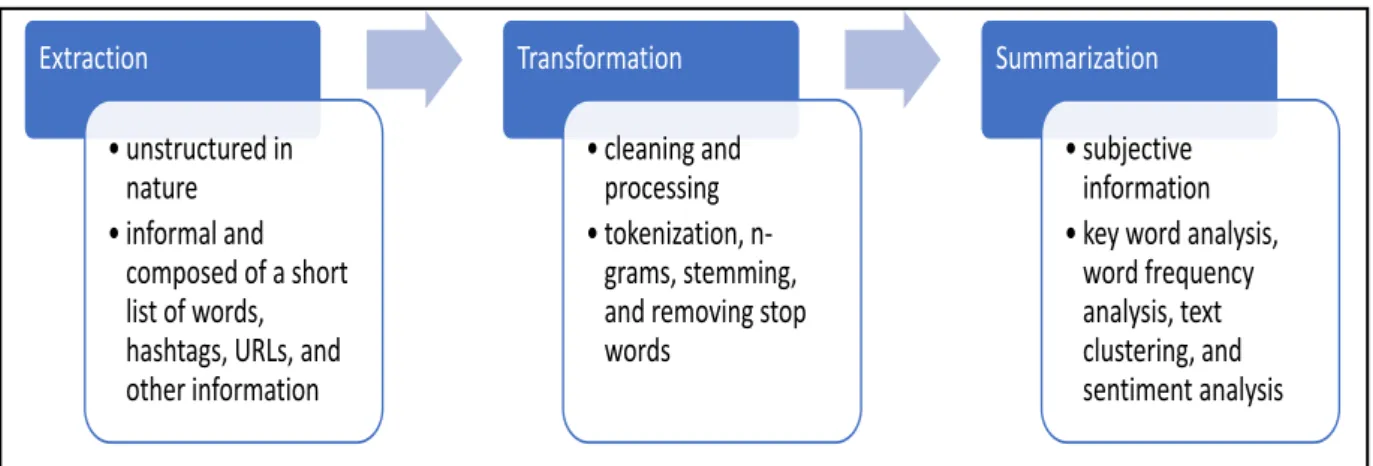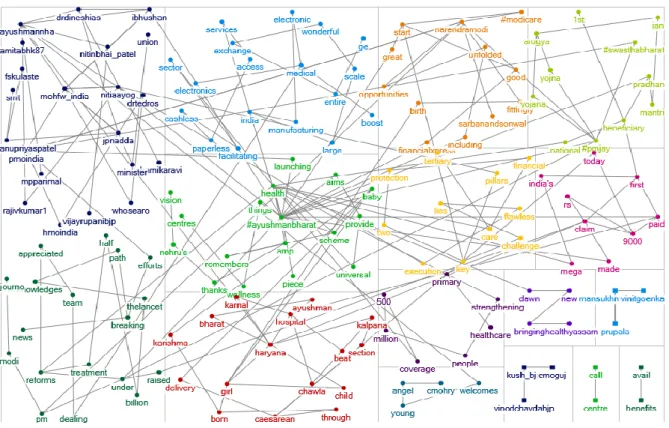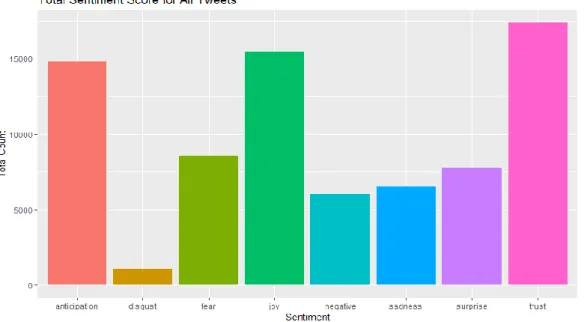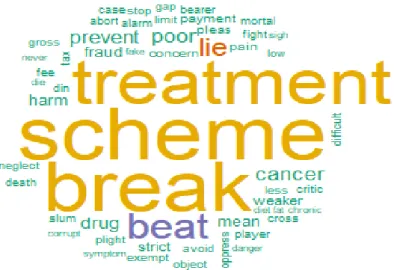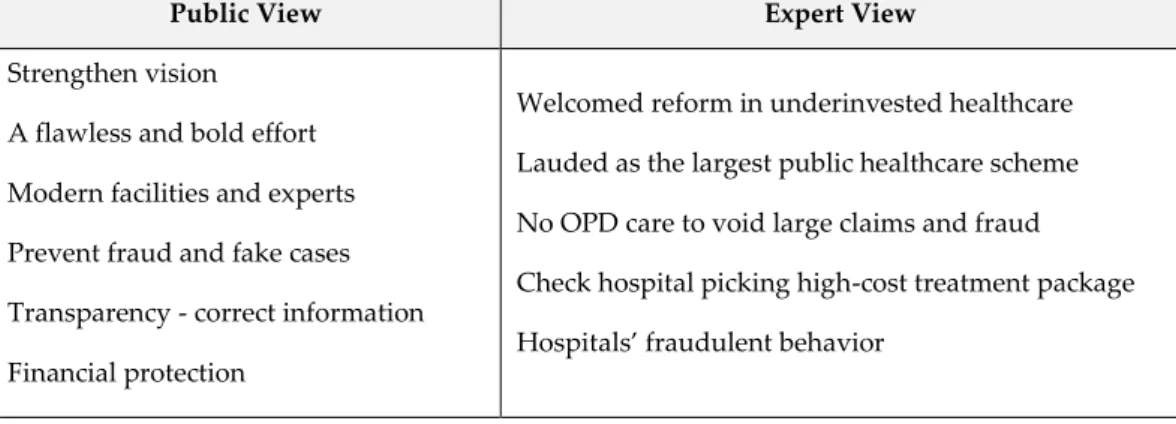The second part includes the existing literature on the policy design domain and that on Social Media Monitoring (SMM) (Bekkers et al., 2013). Co-design is claimed to improve idea generation, service delivery, project management and longer-term results (Steen et al., 2011). However, there has been minimal discussion about the use of SM in the policy design process (Loukis et al., 2017; Hedestig et al., 2018).
Using SMM, the government can passively monitor SM communities related to a specific topic or policy (Loukis & Charalabidis, 2015; Loukis et al., 2017). However, research on the use of SMA for co-production by public agencies is scarce (Loukis et al., 2017; Hedestig et al., 2018). The first challenge is to get a representative from each segment of the population; otherwise, the data may be considered biased (Euripidis et al., 2017).
Determining themes with their associated polarity, negative and positive, represents the relationship between the sentiment of the comments and the evaluations of different aspects of the scheme (Cao et al., 2013). Twitter data contains different languages, unstructured abbreviations and grammar, and informal formats (Rathore et al., 2017; Grover et al. 2018). Assuming that user posts are a function of the emotions of their aspects, the emotions are classified using sentence selection methods (King et al., 2013).
This method is used to recognize the relevant words within each emotion (Ku et al., 2006).
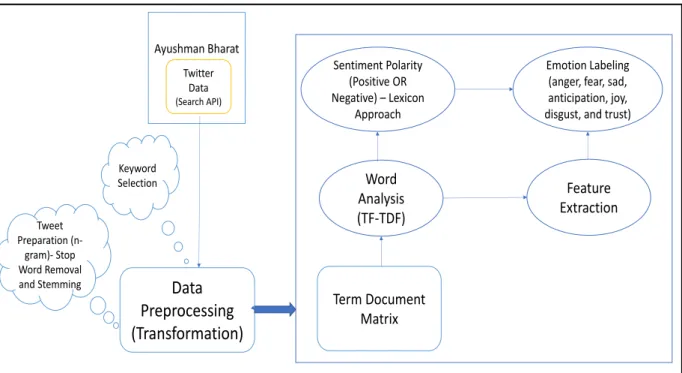
Stage 2 - Semi-structured Interviews
Results and Findings
Text Analysis
Using these topics, a word network clustering approach was used to highlight the themes associated with 'Ayushman Bharat' (Figure 4). For example, the first group has the middle word 'ayushmannha' with some linked words like 'mohfw_india', 'pmoindia', 'nitiaayog' and 'union minister' and various individual stakeholders associated with the healthcare sector such as the Minister of Health and Family Welfare, the Government of India, industry leaders like the President of Reliance. Overall, the findings highlight various themes such as the financial benefits for people, treatments, claim amounts, different stakeholders, reform efforts to restructure healthcare, execution and fraud detection mechanisms (eg digitalisation).
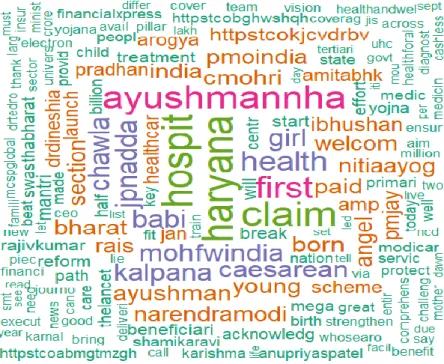
Sentiment Analysis
There is also one dimension of the treatment theme that includes critical diseases, modern facilities due to globalization and robust processes. In the initial stages of its implementation, the scheme was considered to have great potential to impact the healthcare sector. However, concerns were also expressed, which could be seen as the negative side of the scheme (Figure 7).
The scheme covers approximately half a billion people, which in itself is a record number of treatment coverage. Second, public systems need a safe and secure information infrastructure to digitize all processes, i.e. cashless, paperless, etc. In summary, the scheme has significant benefits for around half a billion people, but building the infrastructure to implement it is also a major challenge for the government.
Lack of information about the type of illness (eg cancer) covered by the scheme can limit access to care. Another concern that has been raised relates to the coverage and funding of the scheme - which covers only Low-income families do not contribute directly to taxes, but are the main beneficiaries of the program.
Concerns were also raised about additional costs that the scheme would not cover. Although respondents appreciated the scheme, they also had some concerns about its design and implementation.
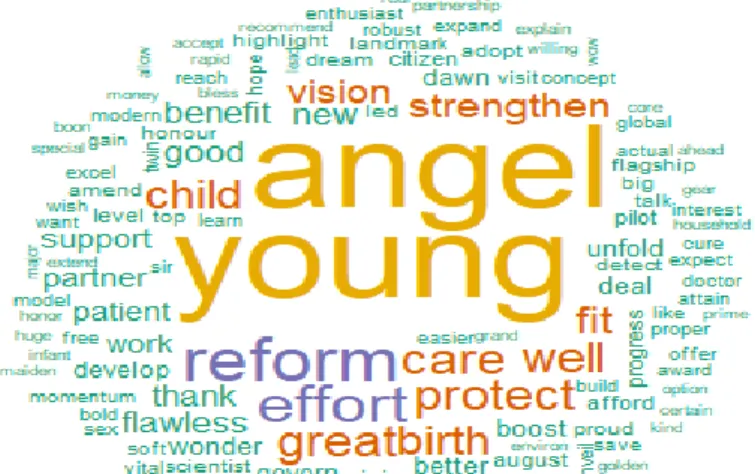
Discussion
- Policy Co-design: Matching Public Opinion with Evolution in Program Design
- Theoretical Implications
- Managerial Implications
- Limitations and Future directions
Little pain during the process of the plan Focus on critical diseases such as cancer The danger of oppression should be avoided ~ neglect death. Two years after the plan's launch, many analysts have called the budget allocation a symbolic gesture (Chatterjee, 2019a; Ghosh & Quadeer, 2019). Two years after the scheme was launched, the scheme is still plagued by fraud by hospitals; however, the government remains optimistic about their ability to control the adverse effects of the model (NITI Aayog Government of India, 2019).
Negative themes The negative themes raised in the tweets are related to the design of the program (Table 1). In-depth interviews with experts suggested that this is one of the main concerns in the design of the scheme. However, it is too early to comment on the effectiveness of the measures taken to control fraud.
Another way hospitals collect money from beneficiaries is when beneficiaries are unsure of reimbursement from insurance companies. Widespread illiteracy in rural areas suggests that this is not an easy task for most beneficiaries. Misinformation can be taken as the most important news because of the manipulation that takes place on SM platforms.
One of the observations from the dataset states that people share (eg, retweet) more tweets that contain more negative sentiment. With this trend, civic engagement may flow in the direction of destroying the current benefits of the scheme. Although we can expect that government officials and agencies are expected to express positive sentiments, magazines, newspapers and academic journals are probably more critical of the scheme.
For example, the reports and public opinion show that most of the grievances against 'Ayushman Bharat' are still about collecting additional money. It is clear that the social disadvantage of the beneficiaries and the high information asymmetry make it difficult for the beneficiaries to participate in a detailed discussion. First, the data may not be the most accurate representation due to limitations in the effectiveness of how public data is extracted from Twitter.
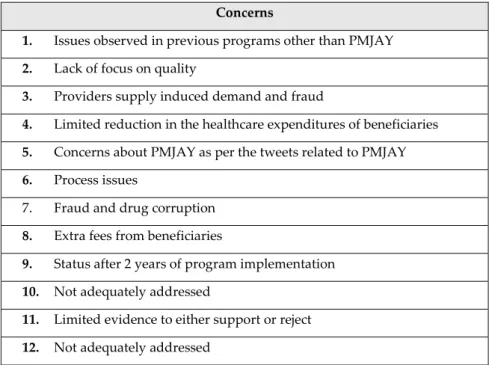
Conclusion
The beneficiaries have limited voices as they can only file complaints in the online grievance system or by calling the helpline. However, due to the widespread illiteracy in rural areas, this is not an easy task for most citizens. Policy makers may need to be more innovative in facilitating the use of online platforms despite lacking a quick fix for social issues such as illiteracy.
For example, OPD care accounts for a significant portion of out-of-pocket expenditure in India and therefore contributes significantly to the improvement effect of healthcare expenditure (Garg & Karan, 2009). Therefore, policy makers and designers of SM platforms must be innovative to respond to the dual responsibility of educating citizens and helping them engage in critical discussions. There are several limitations of this study, and therefore, the conclusions from this study should be used with caution for the following reasons.
Future research could consider the development of an advanced text analysis technique to analyze all language tweets from a single data set. Second, we attribute changes in the program design over the years to SMA; however, the program designers may have been influenced by the knowledge obtained from other sources. Future research on policy co-design requires the collection of SM data over longer time periods and on the extent to which policy design agencies such as NHAI use these SM data.
Given the potential of SMA, policy design and co-design processes can be effective even in developing country contexts, where the most common approach for governments to consider policy feedback remains limited to elections. Our findings also suggest that, contrary to expectations, citizen opinions and expert views were very similar despite the complex and technical nature of the scheme. This may be due to better knowledge of the scheme among citizens due to their previous experiences with similar schemes and extensive dissemination of information about the scheme in the media, including SM.
How can mHealth applications that have been developed in one area of the developing world be adapted for use in others?. Understanding government social media users: An analysis of interactions on immigration, refugees and citizenship Canada twitter and facebook. In Proceedings of the 19th Annual International Conference on Digital Governance Research: Governance in the Data Age (pp. 1-10).
Towards a conceptual framework for the adoption of social media by non-urban communities for non-profit activities: Insights from an integration of major theories of technology acceptance. From e-government to us-government: Defining a typology for citizen co-production in the age of social media. Available on January 19, 2018, retrieved from http://www.mospi.gov.in/sites/default/files/publication_reports/ KI_Health 75th_.
Assessing the state of social media: the case of Mpumalanga Government, South Africa. Accessed on 12 February 2020, retrieved from https://niti.gov.in/sites/default/files/2019-11/NitiAayogBook_compressed.pdf. In Investigating the roles of IT and social media in democratic development and social change (pp. 115-132).
In Proceedings of the 16th ACM SIGKDD international conference on Knowledge discovery and data mining (pp. 783-792). This is an open access article distributed under the terms of the Creative Commons Attribution-NonCommercial 3.0 Australia License, which is non-.
